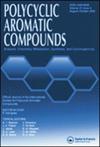(Z)-5-(4-硝基苄基)-3- n(3-氯苯基)-2-硫氧噻唑烷-4- one的合成、晶体结构、分子间相互作用、HOMO-LUMO、MEP、NLO性质和DFT/TD-DFT研究
IF 2.6
3区 化学
Q2 CHEMISTRY, ORGANIC
引用次数: 0
摘要
摘要合成了一种新型杂环化合物(Z)-5-(4-硝基苄基)-3- n(3-氯苯基)-2-硫氧噻唑烷-4- 1 (NCTh),并采用单晶x射线衍射、红外光谱、紫外-可见光谱、核磁共振光谱和质谱等方法对其进行了分析。nth在三斜晶系P-1空间群中结晶。为了验证实验结果,使用6-311 G(d,p)基集的B3LYP泛函进行密度泛函理论(DFT)计算。结果表明,实验结果与理论结果在几何参数上吻合较好。该研究还计算了HOMO-LUMO能量、分子静电势(MEP)和整体化学反应性描述符来评估化合物的反应性。此外,该研究还进行了降低密度梯度和赫什菲尔德表面分析,以揭示吸引、排斥和范德瓦尔斯强、弱相互作用。热力学参数的计算也包括在内。研究了NCTh的非线性光学性质,并通过电偶极矩(µ)、极化率(α)、一阶超极化率(β)和二阶超极化率(γ)等关键参数对其进行了表征。这些特性为该材料在光学和光子技术中的潜在应用提供了见解。此外,进行了分子对接研究,以进一步探索结构-活性关系,特别是在生物学背景下。对接结果显示,配体与蛋白之间存在较强的相互作用,结合能为−10.3 kcal/mol,具有较强的亲和力。此外,计算出的抑制常数(Ki)为0.0281 μM,表明相互作用非常有效,可能与药物设计或生化应用相关。本文章由计算机程序翻译,如有差异,请以英文原文为准。
Synthesis, Crystal Structure, Intermolecular Interactions, HOMO-LUMO, MEP, NLO Properties, and DFT/TD-DFT Investigation of (Z)-5-(4-Nitrobenzylidene)-3-N(3-Chlorophenyl)-2-Thioxothiazolidin-4-One
A novel heterocyclic compound named (Z)-5-(4-nitrobenzylidene)-3-N(3-chlorophenyl)-2-thioxothiazolidin-4-one (NCTh) was synthesized and analyzed using various techniques, including single crystal X-ray diffraction, FT-IR, UV-Vis, NMR spectroscopy, and mass spectral data methods. NCTh was observed to crystallize in the triclinic crystal system P-1 space group. To validate the experimental findings, density functional theory (DFT) calculations were performed using the B3LYP functional with the 6-311 G(d,p) basis set. The results indicated good agreement in geometrical parameters between the experimental and theoretical outcomes. The study also calculated HOMO-LUMO energies, molecular electrostatic potential (MEP), and global chemical reactivity descriptors to evaluate the compound’s reactivity. Additionally, the study conducted reduced density gradient and Hirshfeld surface analyses to reveal attractive, repulsive, and van der Waals strong and weak interactions. The calculation of thermodynamic parameters was also included. The study focused on investigating the nonlinear optical (NLO) properties of NCTh, which were characterized through key parameters such as the electric dipole moment (µ), polarizability (α), first-order hyperpolarizability (β), and second-order hyperpolarizability (γ). These properties provide insights into the material’s potential applications in optical and photonic technologies. Additionally, a molecular docking study was performed to further explore the structure-activity relationship, particularly in a biological context. The docking results revealed a strong ligand-protein interaction, with a binding energy of −10.3 kcal/mol, indicating significant affinity. Moreover, the inhibition constant (Ki) was calculated to be 0.0281 μM, suggesting a highly potent interaction, which could be relevant for drug design or biochemical applications.
求助全文
通过发布文献求助,成功后即可免费获取论文全文。
去求助
来源期刊

Polycyclic Aromatic Compounds
化学-有机化学
CiteScore
3.70
自引率
20.80%
发文量
412
审稿时长
3 months
期刊介绍:
The purpose of Polycyclic Aromatic Compounds is to provide an international and interdisciplinary forum for all aspects of research related to polycyclic aromatic compounds (PAC). Topics range from fundamental research in chemistry (including synthetic and theoretical chemistry) and physics (including astrophysics), as well as thermodynamics, spectroscopy, analytical methods, and biology to applied studies in environmental science, biochemistry, toxicology, and industry. Polycyclic Aromatic Compounds has an outstanding Editorial Board and offers a rapid and efficient peer review process, as well as a flexible open access policy.
 求助内容:
求助内容: 应助结果提醒方式:
应助结果提醒方式:


